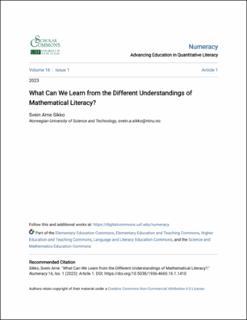| dc.contributor.author | Sikko, Svein Arne | |
| dc.date.accessioned | 2023-01-12T12:42:35Z | |
| dc.date.available | 2023-01-12T12:42:35Z | |
| dc.date.created | 2022-08-26T09:03:37Z | |
| dc.date.issued | 2023 | |
| dc.identifier.citation | Numeracy: Advancing Education in Quantitative Litracy. 2023, 16 (1), . | en_US |
| dc.identifier.issn | 1936-4660 | |
| dc.identifier.uri | https://hdl.handle.net/11250/3043055 | |
| dc.description.abstract | Mathematical literacy, quantitative literacy, numeracy, matheracy, disciplinary literacy, and content-area literacy are among a plethora of terms used to link mathematics and literacy. In addition to this abundance of terms, the content of the terms is not precise, and in some cases the terms are used interchangeably. I delve into this landscape and dissect the meaning of each of them. From such an analysis of mathematical literacy, numeracy, and quantitative literacy, we learn about the importance of quantitative practices and elementary mathematics in society, including both how mathematics is necessary for everyday life but also how it can be used to change the world. By discussing content-area literacy in mathematics, we learn about text in mathematics and the shortcomings of general text-competence approaches are revealed. By analyzing disciplinary literacy in mathematics, we learn to appreciate mathematics as a subject with its own language, tools, techniques, and ways of thinking that emphasize inquiry and experimentation following the heritage from Euclid, Archimedes, Newton and Euler. Having so many competing terms and approaches has a negative effect on the academic discourse but also on the communication with the world outside of academia. | en_US |
| dc.description.abstract | What Can We Learn from the Different Understandings of Mathematical Literacy? | en_US |
| dc.language.iso | eng | en_US |
| dc.publisher | Berkeley Electronic Press | en_US |
| dc.relation.uri | https://digitalcommons.usf.edu/numeracy/vol16/iss1/art1/ | |
| dc.rights | Navngivelse-Ikkekommersiell 4.0 Internasjonal | * |
| dc.rights.uri | http://creativecommons.org/licenses/by-nc/4.0/deed.no | * |
| dc.title | What Can We Learn from the Different Understandings of Mathematical Literacy? | en_US |
| dc.title.alternative | What Can We Learn from the Different Understandings of Mathematical Literacy? | en_US |
| dc.type | Peer reviewed | en_US |
| dc.type | Journal article | en_US |
| dc.description.version | publishedVersion | en_US |
| dc.source.pagenumber | 23 | en_US |
| dc.source.volume | 16 | en_US |
| dc.source.journal | Numeracy: Advancing Education in Quantitative Litracy | en_US |
| dc.source.issue | 1 | en_US |
| dc.identifier.doi | https://doi.org/10.5038/1936-4660.16.1.1410 | |
| dc.identifier.cristin | 2046203 | |
| cristin.ispublished | true | |
| cristin.fulltext | original | |
| cristin.qualitycode | 1 | |

